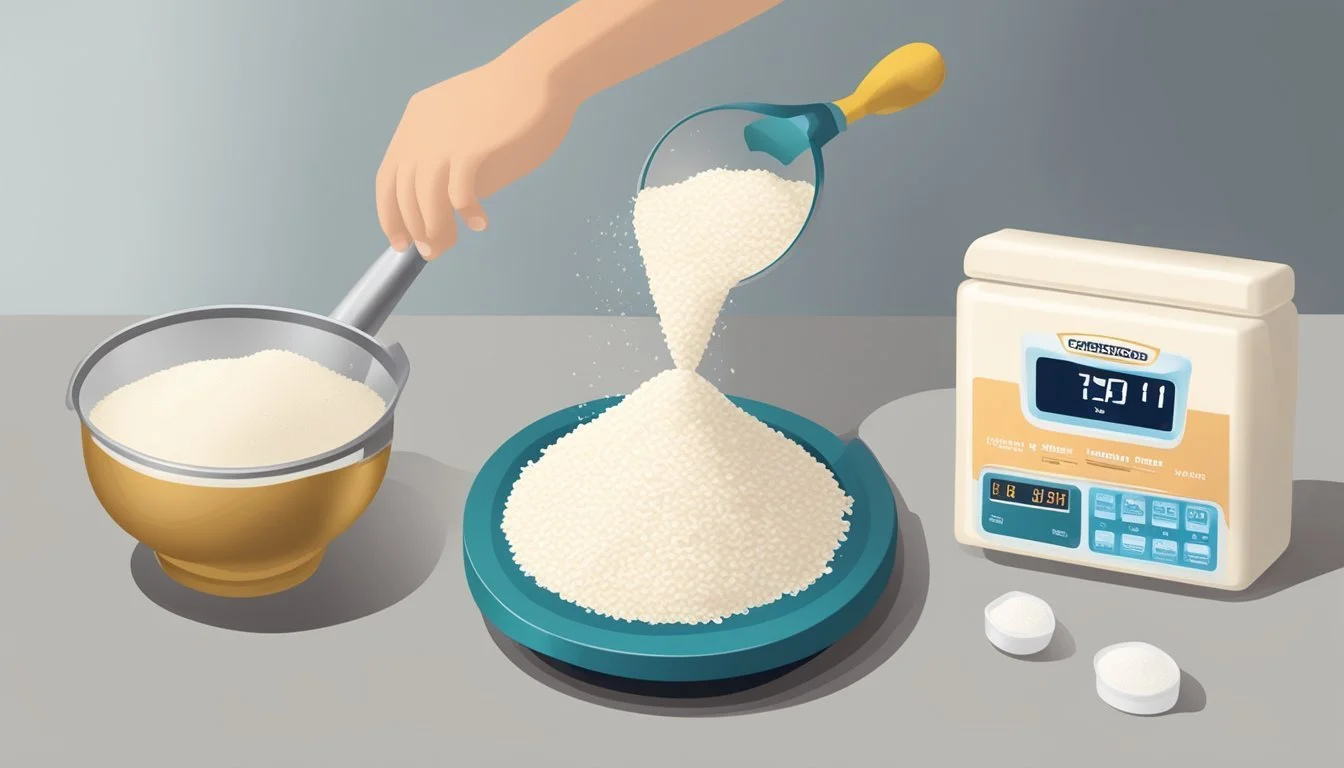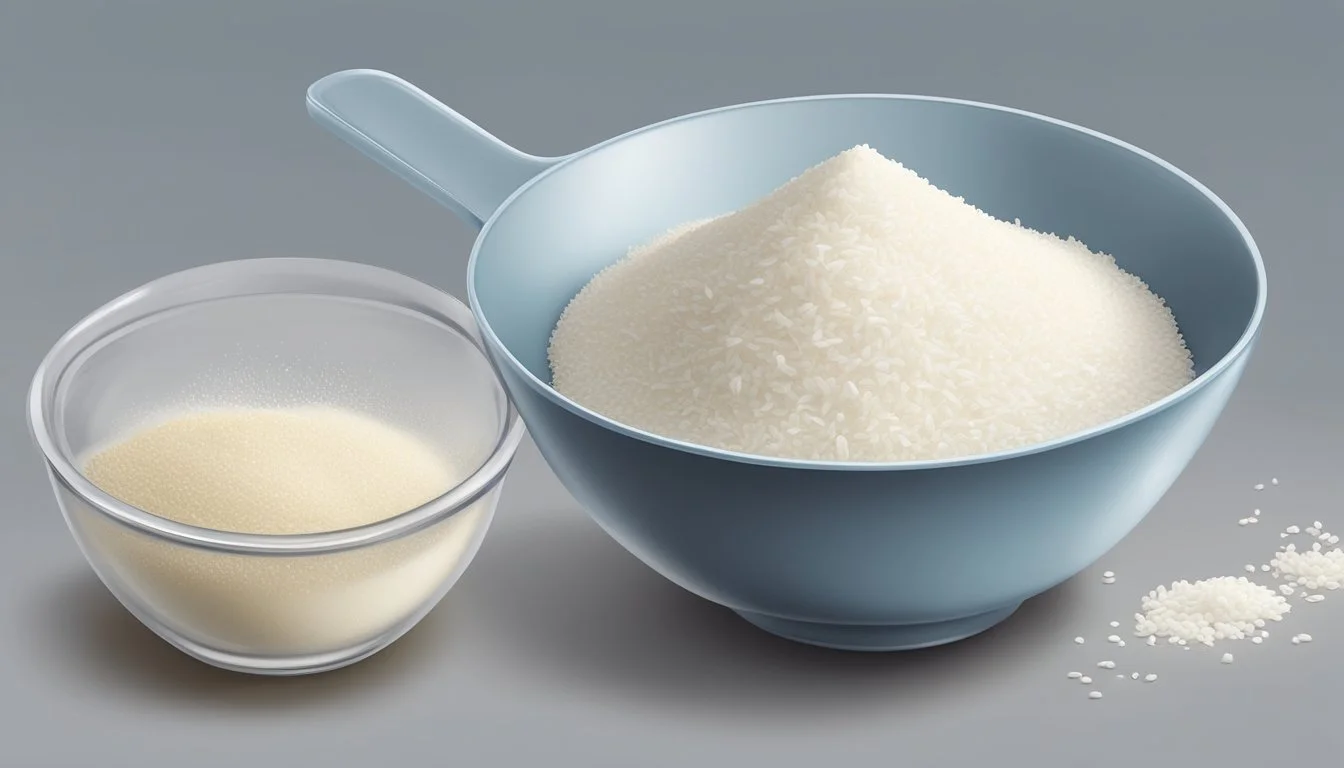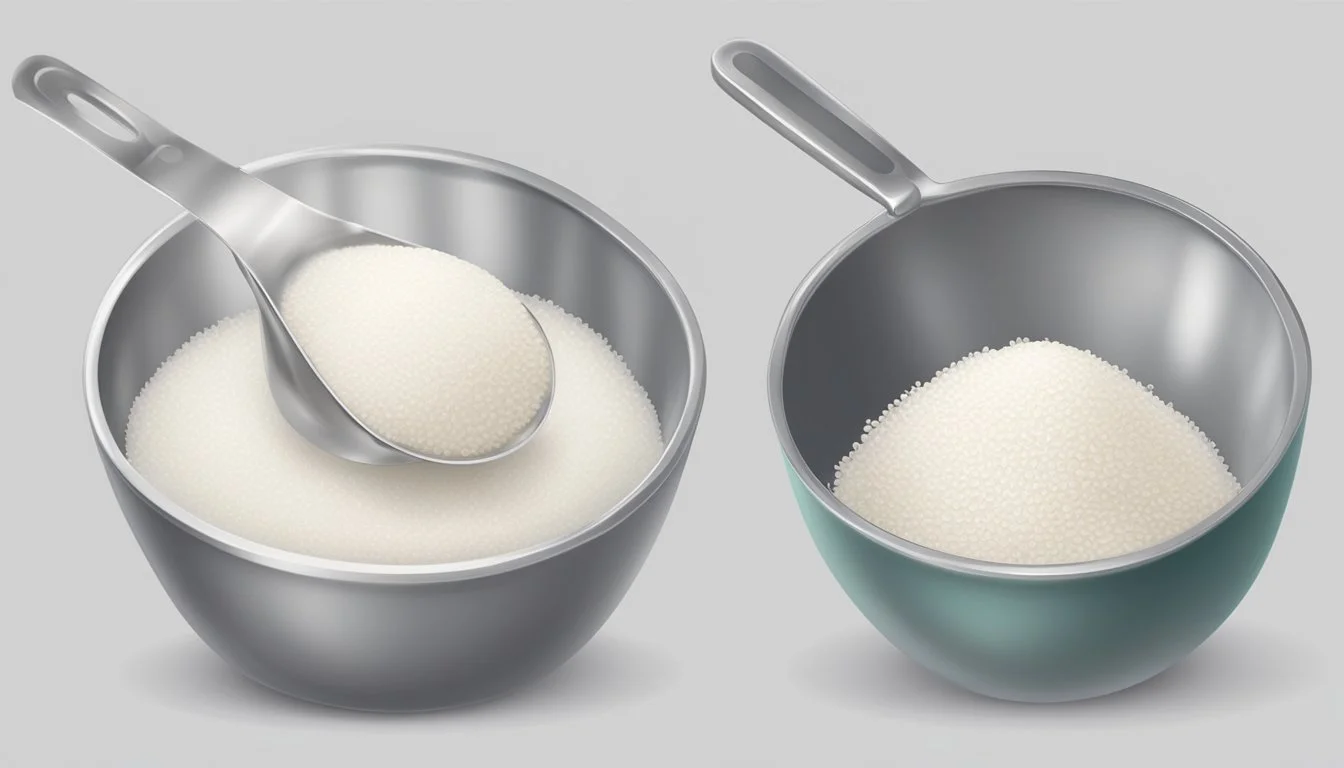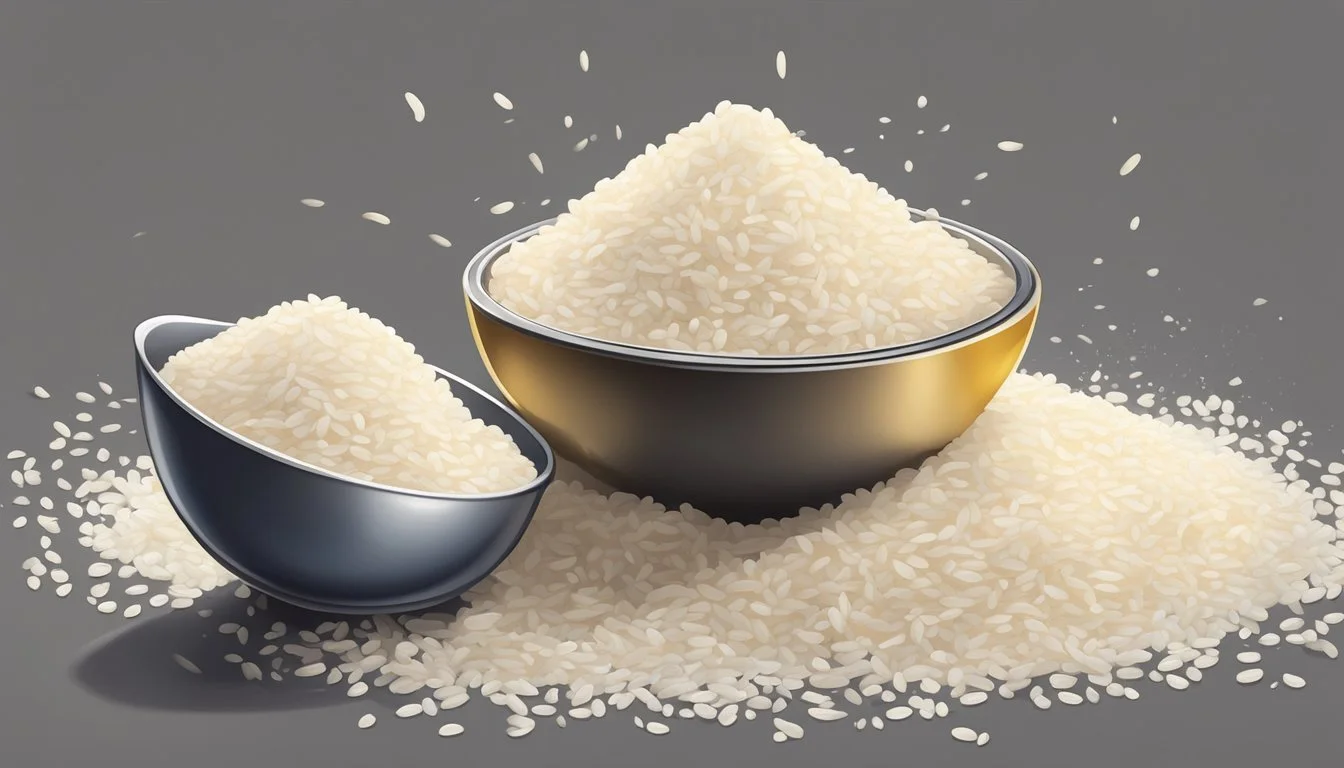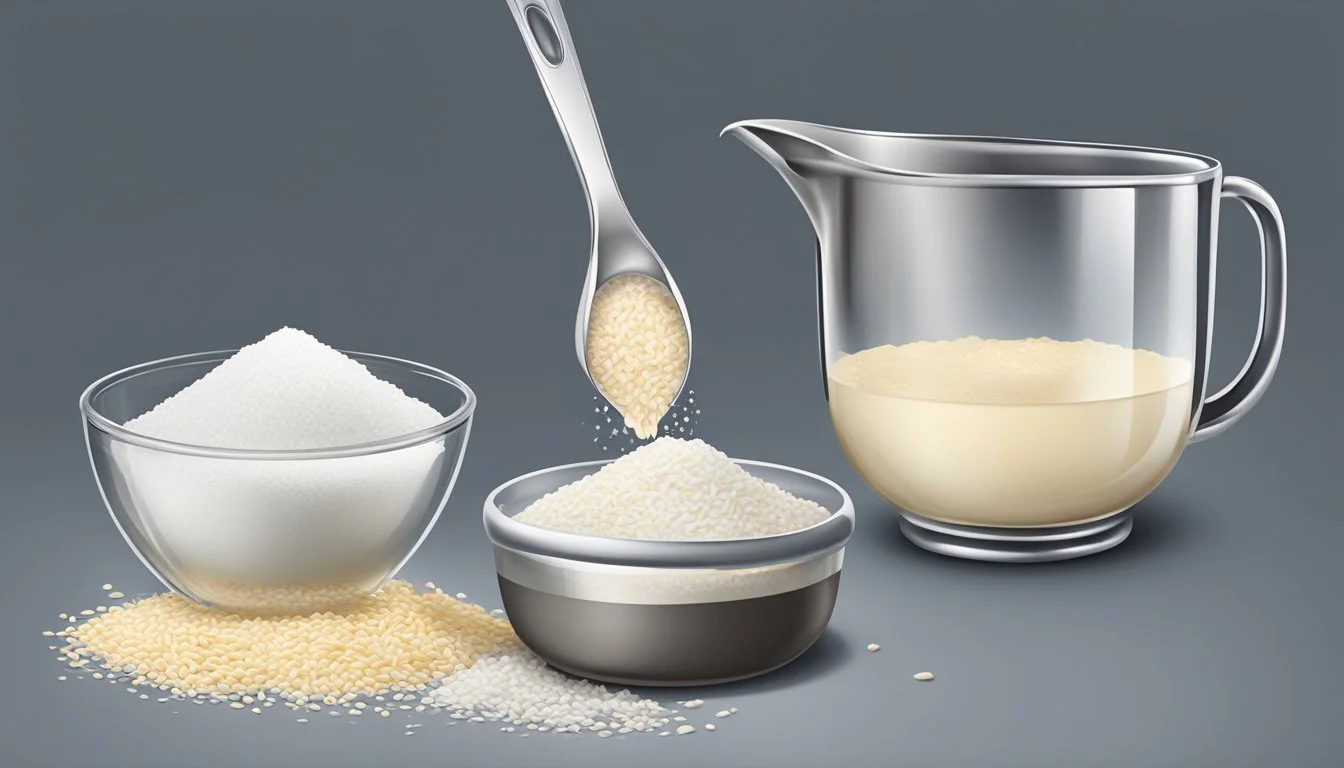How Many Tablespoons in a Pound of Rice Flour
Precise Measurements for Bakers
When it comes to baking or cooking with rice flour, precision is crucial for achieving the desired consistency and taste of the dish. Converting weight to volume measurements is a common practice in the kitchen, especially for ingredients like rice flour, which are often sold by weight. The exact volume that corresponds to a pound of rice flour is essential information for any recipe that requires this gluten-free alternative to traditional wheat flour.
In the realm of culinary measurements, one pound of white rice flour translates to approximately 45.36 tablespoons. This conversion is based on the assumption that rice flour has a similar density to other types of flour, which may not always be the case due to differences in grinding and settling.
To ensure accuracy, a scale or converting tool is recommended since the density of rice flour can affect the conversion rate from pounds to tablespoons. A straightforward formula for this conversion does not universally apply; therefore, it's always best to refer to specific guidelines or conversion tools tailored to rice flour for the most precise measurement.
Understanding Measurements in Baking
Accurate measurements are crucial in baking to ensure consistent results. Baking is as much a science as it is an art; precise measurements can be the difference between success and a less desirable outcome.
Volume vs. Weight
In the culinary arts, bakers often face the decision of measuring ingredients by volume or weight. Volume refers to the space an ingredient occupies, typically measured in cups, tablespoons, and teaspoons. Weight, on the other hand, is the mass of an ingredient, measured in grams, ounces, or pounds.
For instance, flour can be measured by volume using measuring cups, but this method can lead to variations due to how the flour is packed into the cup. Weight measurement is more accurate, as it accounts for the exact mass, irrespective of the ingredient's density or packing.
Common Baking Ingredients
Here are some standard conversions for common baking ingredients from volume to weight:
Flour: 1 cup of all-purpose flour typically weighs 120 grams or 4.23 ounces.
Sugar (Granulated): 1 cup of granulated sugar generally weighs 200 grams or 7.05 ounces.
Butter: 1 tablespoon of butter usually weighs about 14 grams or 0.49 ounces.
The weight of 1 pound of rice flour, which is not commonly measured in tablespoons, would be approximately 453.59 grams, as there are 453.59 grams in one pound.
Importance of Accuracy
Accurate measurements are pivotal to achieving the desired texture and flavor in baked goods. Baking requires precise chemical reactions, and even a slight deviation can alter the final product. For example, using too much flour can lead to a dry and dense cake, while too little may result in a batter that cannot hold its structure.
Using a kitchen scale can greatly improve the accuracy in measuring the ingredients, especially for items like flour and sugar, which are prone to settling and can vary significantly in volume. A digital scale can provide readings down to the gram, ensuring that recipes are followed with precision.
Conversion Basics
In the context of cooking and baking, accurate conversions between different units of measure are essential for achieving the desired results. These conversions are particularly important when dealing with ingredients such as rice flour, which have specific densities and weights.
Grams to Tablespoons
For dry ingredients like rice flour, the conversion from grams to tablespoons depends on the ingredient's density. One gram of rice flour is approximately 0.689 tablespoon. A precision scale can be indispensable for these conversions since they offer the most accurate measurement.
Pounds to Ounces
When converting pounds (lb) to ounces (oz), one should remember that one pound equals 16 ounces. This conversion is linear and does not depend on the ingredient's type since it deals with mass, making it universal across all dry ingredients.
Liquid vs. Dry Measurements
It is important to distinguish between liquid and dry measurements, as they are not directly interchangeable. Liquid measurements are typically in fluid ounces, liters, or milliliters. In contrast, dry measurements account for the mass of an ingredient in tablespoons (tbsp) or teaspoons (tsp). One should not use liquid measuring cups for rice flour or other dry ingredients as this can lead to imprecise results.
Specifics of Rice Flour
In the culinary world, rice flour is distinct for its unique properties and versatility. It is often a go-to ingredient for gluten-free recipes and provides different results when compared to wheat-based flours.
Rice Flour Characteristics
Rice flour, derived from ground rice, is a gluten-free flour alternative with a granular texture and a slightly nutty taste. Gluten-free encompasses that it does not contain the protein composite of gluten found in wheat, making it ideal for those with gluten intolerance or celiac disease. The texture can vary from fine to coarse, affecting its flow and behavior in recipes. Rice flour also has a higher carbohydrate content and lacks the binding qualities of gluten, resulting in a different texture in baked goods.
Comparing Rice Flour to Other Flours
When substituting rice flour for wheat-based flours like all-purpose flour, bread flour, or cake flour, it's crucial to understand the outcome differences.
All-purpose flour: A staple in baking that contains gluten, yielding elastic doughs and structured baked items.
Bread flour: High in gluten, perfect for chewy bread with a strong, resilient crumb.
Cake flour: Finely milled with a lower protein content, ideal for tender baked goods.
Rice flour, conversely, produces a lighter, distinctively crisper texture, lacking the chewiness imparted by gluten. It generally leads to a more delicate and crumbly baked product, such as a rice flour cake, which may require xanthan gum or other binding agents to mimic the structure provided by gluten.
Rice Flour Conversion Factors
Accurate measurement conversions are key for successful recipes. For rice flour:
1 pound of rice flour = approximately 45 to 58 tablespoons (variance due to flour density).
To illustrate, a weighed measurement:
Weight (Pounds) Rice Flour (Cups) Rice Flour (Tablespoons) 1 4.25 ~45 - 58
For instance, 1.5 pounds of rice flour roughly equates to 4.25 cups. This conversion is valuable for adapting recipes or for those requiring precise measurements in their baking, where the flow and consistency of the flour can affect the final product's quality.
Measurement Tools and Techniques
When measuring rice flour in the kitchen, precision is key. Bakers and chefs often need to convert weight to volume, specifically from pounds to tablespoons. Understanding the tools and techniques for accurate measurement is essential for successful culinary outcomes.
Using a Kitchen Scale
A kitchen scale is an indispensable tool for chefs and bakers. It allows for precise measurement of ingredients by weight, which is more accurate than volume measurements. For rice flour, one should place a bowl on the kitchen scale, zero out its weight, and then add the rice flour until the desired weight in pounds is reached. Most digital kitchen scales offer the option to display the weight in different units, including pounds and grams.
Measurement Conversions
Converting pounds to tablespoons involves using a conversion ratio. Since one pound of rice flour is equivalent to approximately 45.36 tablespoons, having a converter or calculator handy simplifies this process. Online culinary converters and conversion calculators can provide immediate conversions from pounds to tablespoons, as well as to other units like US cups:
1 pound of rice flour = 45.36 tablespoons
1 pound of rice flour = approximately 2.83 US cups (based on 1 US cup of rice flour equaling roughly 16 tablespoons)
Tips for Measuring Flours
When measuring flours, a few techniques can help ensure accuracy:
Fluff the flour before measuring to prevent it from being packed down.
Spoon the flour into the measuring spoon or cup rather than scooping, which can lead to overpacking.
Level off the excess with the back of a knife to get a precise measure.
For those who do not have a scale, the rule of thumb for rice flour is to use the spoon and level method to measure it into US cups and then convert to tablespoons if needed. Remember, compacting the flour by scooping directly with measuring tools may result in using more flour than intended, affecting the recipe.
Extensive Baking Entity Guide
This guide provides precise measurements for the essential components in baking, ensuring accuracy and consistency in your culinary creations.
Butter, Fats, and Oil Measurements
Butter is a core ingredient in baking, and correct measurement is crucial for desired texture and flavor. Butter typically comes in sticks with clear markings for tablespoons and cups. For instance:
1/4 cup butter = 4 tablespoons
1/2 cup butter = 1 stick = 8 tablespoons
Oils such as vegetable or canola are generally measured in fluid ounces or milliliters but can be converted to tablespoons or cups for ease of use.
1 cup oil = 16 tablespoons
Common fats like margarine follow similar measurements to butter and are interchangeable in some recipes:
1 cup margarine = 2 sticks = 16 tablespoons
Sweeteners and Sugar Varieties
Sweeteners provide flavor and texture to baked goods. Granulated sugar and brown sugar are often measured by volume:
1 cup granulated sugar = 200 grams
1 cup packed brown sugar = 220 grams
Powdered sugar, used for icings and dustings, is lighter:
1 cup powdered sugar = 120 grams
When using sweeteners like honey or maple syrup, they generally weigh heavier than granulated sugar, so adjustments may be necessary.
1 tablespoon honey = 21 grams
Alternate Ingredients and Substitutions
Alternative and substitute ingredients allow for dietary flexibility and variation in texture. White rice flour is a common gluten-free flour alternative:
1 cup white rice flour = 158 grams
Other flours like almond or coconut flour have different weights:
1 cup almond flour = 96 grams
1 cup coconut flour = 128 grams
For nuts such as almonds or walnuts, the weight will differ based on whether they are whole, sliced, or ground:
1 cup whole almonds = 143 grams
1 cup chopped walnuts = 117 grams
Chocolate should be melted carefully to maintain consistency, and pieces are often measured by weight:
1 cup chocolate chips = 180 grams
Use of cornstarch for thickening demands precision:
1 tablespoon cornstarch = 8 grams
When substituting eggs with other binders like chia seeds or flaxseeds, the texture and binding properties can differ, so specific ratios should be followed:
1 egg = 1 tablespoon flaxseed + 3 tablespoons water (after resting it becomes gelatinous, which can mimic egg's binding property)
Practical Application and Uses
Understanding the conversion between tablespoons and pounds of rice flour serves as a critical skill for precise baking, a practical teaching resource, and a necessary facet of specialized culinary practices.
Baking at Home
Home chefs often require precision when following recipes to ensure successful outcomes, especially when baking. For rice flour, a common gluten-free alternative, 1 pound is equivalent to approximately 45.36 tablespoons. This conversion is especially useful when a recipe calls for smaller quantities, or when a cook needs to adjust a recipe for different serving sizes.
Educational Aspects of Baking
For students delving into the culinary arts, mastering the ability to convert measurements is a key competency. Rice flour conversion serves as an excellent teaching tool. Instructors can demonstrate the difference in density and volume between various flours, such as comparing rice flour to all-purpose flour or semolina. Students learn that unlike denser flours, rice flour requires a greater volume to reach one pound, understanding the specificity of each ingredient including poppy seeds or breadcrumbs.
Specialized Cooking and Baking
Chefs specializing in dietary restrictions, such as gluten intolerance, heavily rely on rice flour. They must be adept at converting weights to volumes for scalability of recipes. Specialty items, for instance, those including chia seeds or couscous (What wine goes well with couscous?), might necessitate precise conversions for consistent texture and flavor, where using cups or tablespoons is more feasible than a scale. Eggs, often used to bind in gluten-free baking, underscore the importance of accuracy in these small, yet impactful, measurements.
Building and Maintaining a Kitchen
A well-constructed and maintained kitchen is the backbone of successful baking. Special attention to equipment quality and environment optimization are vital, alongside adherence to safety and rigorous cleaning practices.
Essential Baking Equipment
To ensure precision in baking, one must start by acquiring an accurate good thermometer. This is crucial for monitoring the oven's internal temperature. In the realm of ovens, options range from conventional to specialized pizza ovens. Fire-bricks and fire-clay are common materials for crafting durable and efficient pizza ovens. Those passionate about a robust baking setup might consider building an oven from refractory concrete and heat-resistant mortar, ensuring longevity and consistent cooking results. Whether the baker prefers a rectangle shape or a round igloo design, quality materials lead to superior oven performance.
When opting for a DIY approach, such as constructing a vintage forum for bread baking, it is imperative to use proper thermal insulation and a concrete cladding layer to maintain the required temperatures and prevent heat loss.
Creating the Ideal Baking Environment
Bakers should create a baking environment that maintains consistent temperatures and minimal humidity. The correct application of thermal insulation around the baking area can significantly enhance temperature regulation. For those who build a custom oven, it's advisable to maintain the structure with periodic checks and touch-ups using refractory concrete to address wear and tear.
Safety and Cleaning Practices
Safety in the kitchen is not negotiable; having a well-maintained oven, whether a sleek modern appliance or a custom-built pizza oven, ensures reduced risks of accidents. Owners should check for cracks or damage regularly, especially when using ovens built with fire-bricks and heat-resistant mortar.
To maintain a kitchen, one must adopt thorough cleaning practices. A mixture of fire-clay and water can be used to clean and renew oven surfaces. All baking equipment should be cleaned after each use, and deep cleaning scheduled regularly. Surfaces and tools are best kept free of flour residues and other baking ingredients to prevent contamination and pests.
Maintaining a kitchen demands dedication to quality equipment, a well-regulated environment, and unwavering attention to safety and cleanliness.
Health and Nutritional Information
Understanding the health and nutritional information of baking ingredients, such as rice flour, is essential for those looking to maintain a balanced diet while indulging in baked goods. It is important to consider the impact of each ingredient on one's health, the nutritional content they provide, and possible healthier alternatives.
Impact of Baking Ingredients on Health
The choice of baking ingredients can significantly influence the nutritional value of the finished product. For instance, rice flour is a common substitute for wheat flour, which can be beneficial for those with gluten intolerance. However, one must be mindful of the glycemic index and potential allergens present in alternative flours to avoid adverse health effects.
Nutritional Values in Baking
A typical serving of rice flour, which is about 1 cup (158g), contains approximately 578 calories. It provides a modest amount of protein and fat, with nutritional values per serving being roughly:
Calories: 578
Total Fat: 2.2g
Saturated Fat: 0.6g
Polyunsaturated Fat: 0.6g
Carbohydrates: 127.4g
Dietary Fiber: 3.7g
Protein: 9.4g
When considering the nutritional content for baking, one should also factor in the levels of essential amino acids such as L-lysine, which is important for protein synthesis and overall health.
Healthy Baking Alternatives
In seeking healthier baking alternatives, integrating fruits like papaya into recipes can enhance nutritional content by providing vitamins, minerals, and dietary fiber. Using ingredients high in nutritional values can contribute to a healthier end product. For example, substituting sugar with mashed papaya not only reduces calorie intake but also adds a natural sweetness along with the health benefits of the fruit.
Additional Resources
In the context of translating pounds of rice flour to tablespoons, additional resources can enhance accuracy and support bakers in their culinary projects. These resources range from online tools to interactive communities.
Online Calculators and Converters
Online calculators provide an instant and precise method of conversion for various ingredients, including rice flour. They typically allow users to input the quantity in pounds and automatically generate the corresponding amount in tablespoons.
Accuracy: Utilizing an online calculator ensures that measurements are precise, which is crucial to baking success.
Saving Money: Correct measurements prevent waste of ingredients, ultimately saving money.
Examples of such resources include:
Web-based Conversion Calculators: Websites offering conversion tools often come with detailed instructions to guide users.
Mobile Apps: These are particularly useful for conversions on-the-go and often come with added features such as saving frequently used conversions.
Baking Forums and Communities
Baking forums and communities are valuable for anyone looking to refine their baking skills or troubleshoot recipes. Members can provide feedback, share experiences, and offer conversion tips.
Sharing Knowledge: Seasoned bakers may share their insights on substitutes for food additives or offer advice on measurement equivalents.
Feedback: Posting specific questions on forums can lead to receiving tailored advice that can improve baking techniques.
Feedback and Improvement
Feedback mechanisms play a critical role in the improvement of culinary skills. Engaging with other bakers and using online platforms to share results can lead to constructive feedback.
Continuous Learning: Bakers can correct mistakes and learn new methods through constructive criticism from peers.
Recipe Enhancement: Feedback can also guide bakers to adjust recipes for better results, whether it's using less of an ingredient or tweaking the process.
Users can consider:
Online Survey Tools: For collecting feedback on specific baking techniques or recipes.
Comment Sections: Often found in baking blogs or recipe sites where users can leave and read feedback.
Global and Cultural Aspects
In the context of baking, the conversion of rice flour from pounds to tablespoons is not just a matter of measurements but also a gateway into the diverse baking traditions and cultural techniques that shape global cuisines.
Baking Traditions Around the World
Baking traditions reflect the rich tapestry of cultural practices seen around the world. In Canada, for example, baking often incorporates locally sourced ingredients, integrating wheat and oats, with rice flour sometimes being used in gluten-free recipes. This is indicative of a broader trend where international cuisines adapt based on dietary needs and availability of resources. Baking with rice flour is also prominent in other regions, such as certain Asian countries, where rice is an agricultural staple, influencing both savory and sweet dishes.
The Influence of Culture on Baking Techniques
Baking techniques are deeply intertwined with the culture from which they originate. Cultural differences appear not only in the ingredients used but also in the methods of preparation. In Florida, the influence of Latin American cuisines can be seen where rice flour is used in making tortillas and arepas, demonstrating a blend of indigenous and Spanish culinary traditions. Globally, each culture influences baking by its distinct approach—whether it's the flaky layers of French pastry or the steamed buns from China. These variations underscore the adaptability and innovation inherent to baking across cultures.
Conceptual Understanding
Understanding the conversion of a pound of rice flour to tablespoons requires clarity on what a pound is and how it relates to other units of measurement.
What is a Pound?
A pound (lb) is a unit of weight used in the United States customary and other systems of measurement. A pound is legally defined as exactly 453.59237 grams. The pound originates from the Roman "libra," which is why the abbreviation "lb" is used. In terms of grains, one pound contains 7000 grains.
Units of Measurement
Units of measurement for weight and volume play a critical role in culinary conversions:
Grams (g) and kilograms (kg) are metric units of mass, where 1 kilogram equals 1000 grams, and it equates to approximately 2.20462 pounds.
Tablespoons (tbsp) are units of volume used in cooking to measure liquids and dry goods. In the United States, one tablespoon is equivalent to 14.7868 milliliters.
US tablespoons (US tbsp) specifically refer to the United States customary tablespoon, which differs slightly from the UK Imperial tablespoon.
In the context of rice flour, a pound of this ingredient is equivalent to approximately 45.36 tablespoons, based on average measurements, taking into account the specific density and coarsiveness of rice flour compared to other types of flour.
Baking Science
When measuring ingredients such as rice flour, the precision affects the chemical reactions that occur during baking. Baking is a science where every component plays a pivotal role in the final product.
The Chemistry of Baking
In baking, the chemistry involves complex reactions between ingredients that influence texture, flavor, and rise. For rice flour, a specific amount measured in tablespoons ensures it successfully fulfills its role, typically as a structure-providing starch. The conversion from weight to volume, in this case, pounds to tablespoons, must be accurate to maintain the delicate balance of ingredients. The lack of gluten in rice flour affects the chemistry, often requiring different proportions compared to wheat flour for desired results.
Role of Ingredients in Baking
Each ingredient in a baking recipe has a precise purpose:
Rice flour: It provides structure and is often used in gluten-free baking. Its consistency and interaction with liquids are different from wheat flour, thereby affecting the science of the recipe.
Leavening agents (like baking soda or powder): They release gases that expand when heated, causing the dough or batter to rise.
Fats (such as butter or oil): They contribute to the tenderness, flakiness, and flavor of the bake.
The science behind the quantity of rice flour is that one pound is equivalent to approximately 45.36 tablespoons, crucial for achieving the right consistency and texture in gluten-free baking recipes.

